Rowing
Rowing is the act of propelling a boat using the motion of oars in the water by displacing water to propel the boat forward. Rowing and paddling are similar but the difference is that rowing requires oars to have a mechanical connection with the boat, while paddles (used for paddling) are hand-held and have no mechanical connection.
.jpg)
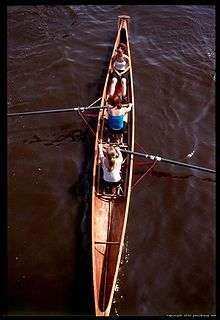
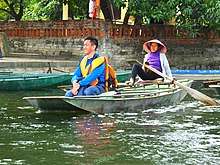
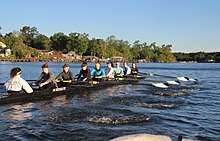
This article focuses on the general types of rowing, such as the recreation and the transport rather than the sport of competitive rowing which is a specialized case of racing using strictly regulated equipment and a highly refined technique.[1]
History of rowing
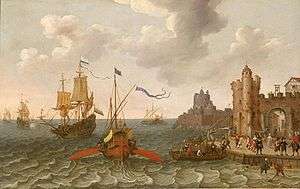
In the Ancient World, all major ancient civilizations used rowing for transportation, commerce, and war.[2] It was considered a way to advance their civilization during war and peace.
Ancient Egypt
The beginning of rowing is clouded in history but the use of oars in the way they are used today can be traced back to ancient Egypt. Whether it was invented in Egypt or something learned from Mesopotamia via trade is not known. However, archaeologists have recovered a model of a rowing vessel in a tomb dating back to the 18-19th century BC.[3]
From Egypt, rowing vessels, especially galleys, were extensively used in naval warfare and trade in the Mediterranean from classical antiquity onward. Galleys had advantages over sailing ships: they were easier to maneuver, capable of short bursts of speed, and able to move independently of the wind.
Ancient Greece
During the classical age of oared galleys, the Greeks dominated the Mediterranean while the Athenians dominated the other Greeks. They used thousands of lower-class citizens to serve as rowers in the fleet.[4] The Classical trireme used 170 rowers;[5] later galleys included even larger crews. Trireme oarsmen used leather cushions to slide over their seats, which allowed them to use their leg strength as a modern oarsman does with a sliding seat. Galleys usually had masts and sails, but would lower them at the approach of combat. Greek fleets would even leave their sails and masts on shore (as being unnecessary weight) if possible.[6]
Northern Europe
The use of oars in rowing instead of paddling came rather late to northern Europe, sometime between 500 BC-1 AD. This change might have been hastened by the Roman conquest of Northern Gaul. However, between 500-1100 AD, combined sailing and rowing vessels dominated trade and warfare in northern Europe in the time that has come to be known as the Viking Age.[7]
Galleys continued to be used in the Mediterranean until the advent of steam propulsion.
Types of rowing systems
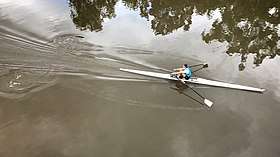
In some localities, rear-facing systems prevail. In other localities, forward-facing systems prevail, especially in crowded areas such as in Venice, Italy and in Asian and Indonesian rivers and harbors. This is not strictly an "either-or", because in different situations it's useful to be able to row a boat facing either way. The current emphasis on the health aspects of rowing has resulted in some new mechanical systems being developed, some (such as the Rantilla rowing method) very different from the traditional rowing systems of the past.
Rearward-facing systems
.jpg)
This is probably the oldest system used in Europe and North America. A seated rower pulls on one or two oars, which lever the boat through the water. The pivot point of the oars (attached solidly to the boat) is the fulcrum. The motive force is applied through the rower's feet. In traditional rowing craft, the pivot point of the oars is generally located on the boat's gunwale. The actual fitting that holds the oar may be as simple as one or two pegs (or thole pins) or a metal oarlock (also called rowlock - "rollock"). In performance rowing craft, the rowlock is usually extended outboard on a "rigger" to allow the use of a longer oar for increased power.
Sculling involves a seated rower who pulls on two oars or sculls, attached to the boat, thereby moving the boat in the direction opposite that which the rower faces. In some multiple-seat boats seated rowers each pull on a single "sweep" oar, usually with both hands. Boats in which the rowers are coordinated by a coxswain are referred to as a "coxed" pair/four/eight. Sometimes sliding seats are used to enable the rower to use the leg muscles, substantially increasing the power available. An alternative to the sliding seat, called a sliding rigger, uses a stationary seat and the rower moves the oarlocks with his feet. On a craft used in Italy, the catamaran moscone, the rower stands and takes advantage of his body weight to increase leverage while sculling.[8]
Forward-facing systems
Articulated or bow facing oars have two-piece oars and use a mechanical transmission to reverse the direction of the oar blade, enabling a seated rower to row facing forward with a pulling motion. Push rowing, also called back-watering if used in a boat not designed for forward motion, uses regular oars with a pushing motion to achieve forward-facing travel, sometimes seated and sometimes standing. This is a convenient method of manoeuvring in a narrow waterway or through a busy harbour. The "Rantilla" system of frontrowing oars uses inboard mounted oarlocks rather than a reversing transmission to achieve forward motion of the boat with a pulling motion on the oars.
Another system (also called sculling) involves using a single oar extending from the stern of the boat which is moved side to side underwater somewhat like a fish tail, such as the Chinese yuloh, by which quite large boats can be moved.[9]
Sampans are rowed by foot in Ninh Bình Province of northern Vietnam.[10]
The Intha people of Burma row forwards using their legs.
The pletna of Slovenia is rowed forward in the standing position with two oars.
Venetian rowing
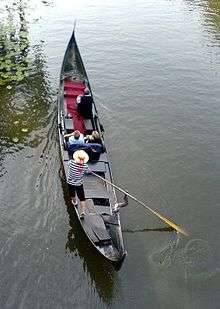
In Venice, gondolas and other similar flat-bottomed boats[11] are popular forms of transport propelled by oars which are held in place by an open wooden fórcola.[12] The Voga alla Veneta[13] technique of rowing is considerably different from the style used in international sport rowing, due to the oarsman facing forward in a standing position. This allows the boat to maneuver very quickly and with agility - useful in the narrow and busy canals of Venice. Competitive regattas are also held using the Venetian rowing technique by using both gondolas and other types of vessels.
There are three styles of Venetian rowing, each slightly different. The first consists of a single oarsman with one oar, standing near the stern of the boat where the oar also acts as a rudder. The second style consists of one or two oarsmen, each with two crossed oars (known as a la valesàna). The third style has two or more oarsmen, rowing on alternate sides of the boat.[14]
Design factors
The classic shapes of rowboats reflect an evolution of hundreds of years of trial and error to get a good shape. Some factors to be considered are waterline length, speed, carrying capacity, stability, windage, weight, seaworthiness, cost, waterline beam, the fullness or fineness of the ends, and trim. Design details are a compromise between competing factors.
Width and height
If the waterline beam (width) is too narrow the boat will be tender and the occupant at risk of falling out, if the beam is too wide the boat will be slow and have more resistance to waves. Overall beam (width) is important. If the rowlocks are too close together the oars will be difficult to use. If the rowlocks are too far apart then the boat will be overly large and rowing will be inefficient, wasting a rower's effort. Sometimes on narrow, faster rowboats for protected waters outriggers are added to increase rowlock separation.
If the freeboard (height of the gunwale above the waterline) is too high then windage will be high and as a result, the boat will be caught by the wind and the rower will not be able to control the boat in high winds. If the freeboard is too low, water will enter the boat through waves. If the boat is designed for one person then only a single rowing position is required. If the rower is to carry a passenger at the stern then the boat will be stern heavy and trim will be incorrect.
Length
When it comes to how long the rowing boat should be, it is a compromise between two factors that will affect the speed of the boat. If the boat is too short, the boat will reach a very low maximum speed. If the boat is too long, there will be more friction and more wet surface. Therefore, the minimum recommended length should be around 16 feet. If the boat is longer than that recommended length, the boat is usually narrower and although faster will generally be more difficult to balance.
Weight
To have good width and the height that ensures the balance of the rowboat, a weight can be added in the bow, alternatively, the boat can supply a second rowing position further forward for this purpose.
There are some advantages and disadvantages that are attributed to the weight of the rowboat. A very light boat will most likely start to slow down as soon as the oar stroke has ended. In contrast, a heavier boat will likely continue to move forward.[15]
Most modern style rowboats are considerably lighter than traditional clinker-built style.[16]
Performance
Spring in the keel or rocker influences how a rowboat performs. Longer, slender race boats have less rocker of about 7.6 cm (3 in). A short 2.4-meter (8 ft) pram dinghy has a rocker of 15–18 cm (6–7 in). Boats with less rocker are easier to row and faster in flat or nearly flat water. However, in any waves a boat with 13–15 cm (5–6 in) of rocker will be more seaworthy—rising over waves rather than going through them. A boat with more rocker can change direction easily whereas a straight keel boat will track well in a straight line but resist turning. High sided and fine-ended boats, such as dories, are affected by wind. Their trim can be altered by using a plastic container of water attached to a rope that can be moved to the bow or stern as need be. Long-distance rowers can keep up a steady 20 strokes per minute compared to a racing shell which can be rowed at 32–36 strokes per minute by fit athletes. A rower can maintain 40 strokes per minute for only a brief period. Longer, narrower rowboats can reach 7 knots (13 km/h; 8.1 mph) but most rowboats of 4.3 m (14 ft) can be rowed at 3–4 knots (5.6–7.4 km/h; 3.5–4.6 mph).[17]
Many old rowboats have very full ends (blunt ends); these may appear at first glance to be bad design as it looks slow, not fast. However a full-ended rowboat will rise to a sea and not dig in as a finer hulled boat might do, thus a compromise needs to be made between the factors of speed and of seaworthiness. This style of rowboat was designed to carry a bigger load and the full sections gave far more displacement. Also older boats were often very heavily constructed compared to their modern counterpart, hence weighed far more. A rowboat designed as a tender carrying occupants to a boat on a mooring might tend to be short, whilst a rowboat for use on rivers and to travel long distances might be long and narrow.
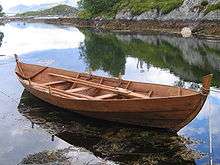
Oars
Over time the design, of both the oars and the blades, has significantly changed. Typically, the oars part that is inboard of the rowlock stayed the same length but the outboard part got shorter. The different lengths of the oars affect both the energy that the rower has to put in as well as the performance, in terms of speed of the rowboat.[18]
A short oar makes quick but short strokes possible. A short oar is easier to use in a narrow creek or a crowded anchorage. This is important in a small tender which may be heavily laden with passengers, limiting the swing of the oars. A short, quick stroke prevents the bow being driven under in choppy waters while heavily laden. Longer oars can be used to produce longer, slower strokes, which are easier to maintain over long distances. Designers may match oar length to the amount of space provided for oar storage in the boat. Wooden oars are generally made of a light, strong wood, such as fir or ash. The blades can either be flat for general use or spooned for faster propulsion.
Whitehall rowboats
The origins of this distinctive and practical craft are unclear. In earlier times, however, builders were often sailors or seafaring men. Successful designs for large and small craft alike evolved slowly and as certain desirable qualities were attained and perfected they rarely changed.
Some hold that the Whitehall rowing boat design was introduced from England. However the famed nautical historian Howard I. Chapelle, cites the opinion of the late W. P. Stephens that in New York City there is a Whitehall Street and this was where the Whitehall was first built. Chapelle, Stephens and others agree that the design came into existence some time in the 1820s in New York City, having first been built by navy yard apprentices who had derived their model to some extent from the old naval gig.
See also
- Coastal and ocean rowing
- College rowing
- Ocean rowing
- Racing shell
- Rowing exercise
- Single scull
- Rowing (sport)
- Sculling
References
- "Speed Rower, Competitive Rowing". Retrieved 2009-02-05.
- "Row Like an Egyptian: A History of Rowing Throughout the Ages". January 31, 2017. Retrieved 10 March 2019.
- "BBC - A History of the World - Object: Egyptian funerary boat". www.bbc.co.uk. Retrieved 26 March 2018.
- The Lost Technology of Ancient Greek,John R. Hale, Publisher: Scientific American, Vol. 274, No. 5 (MAY 1996), pp. 82-85.
- "BBC - Oxford Culture - History of rowing and Henley". www.bbc.co.uk. Retrieved July 30, 2019.
- The Athenian Trireme: The History and Reconstruction of an Ancient Greek Warship. J. S. Morrison, J. F. Coates, N. B. Rankov. Publisher: Cambridge University Press; 2 edition (20 Jul 2000), ISBN 0-521-56456-5, ISBN 978-0-521-56456-4
- "Drakkar Viking Ship 9th -13th century". shipfans.blogspot.com.es. Retrieved 26 March 2018.
- "Remando in piedi sul moscone. (Rowing standing up on the moscone)" (PDF). Retrieved July 30, 2019.
- The Junks and Sampans of the Yangtze G. R. G. Worcester. Publisher: Naval Institute Press; 1971, ISBN 0-87021-335-0, ISBN 978-0-87021-335-9
- Matthew Pike (January 30, 2018). "How Vietnamese Guides Row With Their Feet". TheCulturalTrip.com. Retrieved 2018-10-12.
They row with their feet. As Mrs. Gấm puts it: “Rowing boat by feet is much quicker and less exhausting than by hands.”
- Le barche Archived 2009-07-17 at the Wayback Machine at www.vogaveneta.it (in Italian)
- La forcola - le barche per la Voga alla Veneta Archived 2009-08-08 at the Wayback Machine at www.vogaveneta.it (in Italian)
- Venetian rowing technique at www.venetia.it
- "Boats - Rowing technique". www.venetia.it. Retrieved July 30, 2019.
- "Rowboats, what makes a good rowboat". www.christinedemerchant.com. Retrieved July 30, 2019.
- https://www.virginiarowing.com/sculling-boats.html
- Backyard Boatbulder. p 158–160. J. Welsford. Reed. Auckland 1999.
- "EBSCOhost Login". search.ebscohost.com. Retrieved July 30, 2019.
External links
